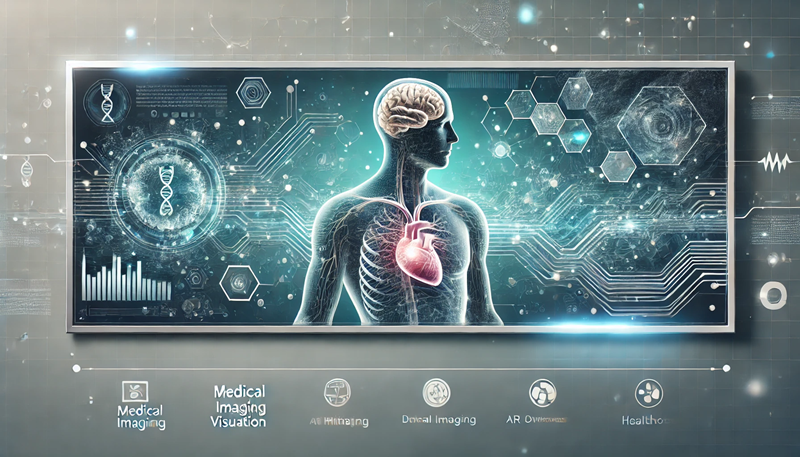The healthcare industry is experiencing a transformative shift, with visualization technologies playing a pivotal role in improving diagnostics, treatments, and patient care. From AI-driven imaging systems to holographic projections, the future of healthcare visualization is reshaping how medical professionals interact with data and make life-saving decisions. This blog delves into the latest insights, trends, and statistics driving the evolution of healthcare visualization.
Why Visualization is the Future of Healthcare
Healthcare visualization refers to the use of advanced technologies to create interactive and detailed visual representations of medical data. These tools enhance understanding, improve accuracy, and streamline workflows in medical settings.
Key Benefits of Healthcare Visualization:
- Enhanced diagnostic precision with detailed imaging.
- Improved surgical outcomes through augmented reality (AR) guidance.
- Interactive learning and training for medical professionals.
- Increased patient engagement with visual aids.
Technological Innovations Driving Healthcare Visualization
1. Artificial Intelligence in Medical Imaging
AI is revolutionizing medical imaging by automating analysis and providing insights that enhance diagnostic accuracy.
Applications:
- AI-powered imaging tools for early detection of diseases like cancer.
- Real-time anomaly detection in X-rays, MRIs, and CT scans.
- Predictive analytics for personalized treatment plans.
Statistic:
According to a 2025 report, the global AI healthcare market is projected to grow at a CAGR of 41.7%, with AI imaging solutions leading the way.
2. Augmented and Virtual Reality (AR/VR)
AR and VR are becoming integral to healthcare visualization, offering immersive environments for diagnosis, surgery, and training.
Use Cases:
- AR overlays during surgeries for real-time anatomical mapping.
- VR simulations for medical training and patient education.
- Rehabilitation programs using immersive VR environments.
Statistic:
The healthcare AR/VR market is expected to reach $11.14 billion by 2028, driven by advancements in visualization technologies.
3. 3D and Holographic Displays
3D and holographic technologies are transforming how medical professionals view and interact with complex data.
Applications:
- Holographic projectors for surgical planning and education.
- 3D-printed anatomical models for pre-surgical analysis.
- Real-time 3D imaging in emergency and trauma care.
Statistic:
A 2024 survey revealed that 62% of surgeons believe 3D visualization significantly improves surgical outcomes.
4. Cloud-Based Visualization Platforms
Cloud technologies enable seamless sharing and analysis of medical data, making visualization accessible across multiple devices.
Benefits:
- Real-time collaboration among healthcare teams.
- Scalable storage for large imaging datasets.
- Remote access to diagnostic tools for telemedicine.
Statistic:
Cloud-based healthcare solutions are projected to grow by 19.2% annually, becoming a backbone for visualization technologies.
Key Trends Shaping the Future of Healthcare Visualization
1. Personalized Medicine
Advanced visualization tools are enabling personalized treatment by providing detailed insights into individual patient data.
2. Integration of IoT Devices
Wearable devices and IoT sensors are contributing to healthcare visualization by providing real-time data streams.
3. Sustainability in Healthcare Visualization
Manufacturers are focusing on eco-friendly designs for visualization tools, reducing energy consumption and waste.
Challenges in Adopting Advanced Visualization Technologies
While the future is promising, challenges remain:
- High Costs: Advanced visualization tools require significant investment.
- Training Requirements: Medical professionals need specialized training to utilize these tools effectively.
- Data Privacy Concerns: Handling large volumes of sensitive data poses security challenges.
Statistics Highlighting the Growth of Healthcare Visualization
- The global healthcare visualization market is expected to reach $23 billion by 2030, driven by advancements in imaging and visualization software.
- Over 80% of healthcare institutions plan to adopt AR/VR visualization tools by 2026.
- Medical imaging accounts for 45% of the total visualization technology use in healthcare.
Real-Life Applications of Healthcare Visualization
1. Oncology
Advanced imaging tools are helping oncologists detect and treat cancer with greater accuracy.
2. Cardiology
3D visualization of heart structures aids in diagnosing and treating complex cardiovascular diseases.
3. Neurology
Holographic imaging allows neurosurgeons to map brain structures in real-time, improving surgical precision.
The Road Ahead: Future Prospects for Healthcare Visualization
1. AI-Driven Holography
AI-integrated holographic projectors will provide more accurate and interactive imaging.
2. Global Accessibility
Affordable and portable visualization tools will bring advanced healthcare to underserved regions.
3. Enhanced Collaboration
Cloud-based platforms will enable global collaboration, improving healthcare outcomes worldwide.
Conclusion: Visualization as the Cornerstone of Future Healthcare
The future of healthcare visualization is bright, with innovations in AI, AR/VR, and holographic technologies leading the charge. These advancements promise to revolutionize diagnostics, surgeries, and patient care, setting new benchmarks in precision and efficiency. As adoption increases, healthcare visualization will play an even more critical role in shaping the global healthcare landscape.
